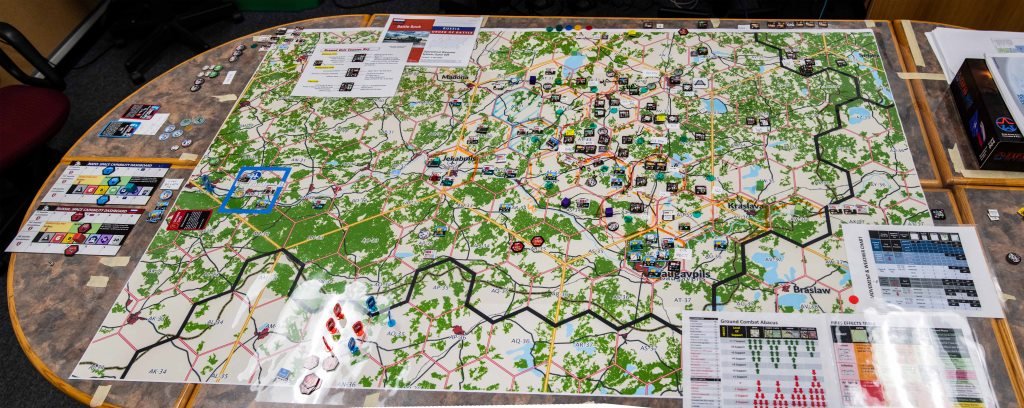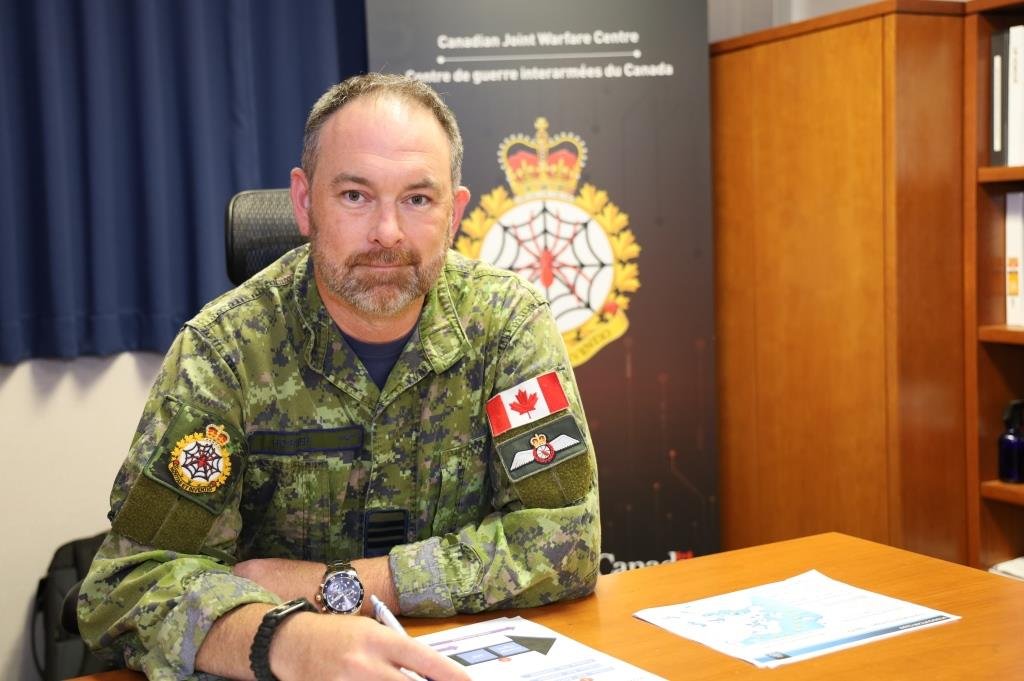JOINT FORCE TRAINING - Wargaming
BY JOETEY ATTARIWALA
WARGAMING
 In Volume 29 – Issue 3 of CDR, we introduced readers to the Canadian Joint Warfare Centre (CJWC) whose mandate is to assist the Canadian Armed Forces (CAF) in finding ways to operate as a Joint Force. This mandate is in place to address the ever-evolving operational environment by implementing best practices, novel concepts and accelerating the adoption of available and emerging technologies and tools.
In Volume 29 – Issue 3 of CDR, we introduced readers to the Canadian Joint Warfare Centre (CJWC) whose mandate is to assist the Canadian Armed Forces (CAF) in finding ways to operate as a Joint Force. This mandate is in place to address the ever-evolving operational environment by implementing best practices, novel concepts and accelerating the adoption of available and emerging technologies and tools.
One of the CJWC’s capabilities is wargaming, which according to Colonel Christopher Horner, the Commanding Officer of CJWC, is a “safe to fail environment with different players looking at simulated or potential real-time events that would walk decision makers through a process of coming up with solutions for potential military operations.”
A wargame, by its very definition, whether analog or digital, is all about humans making decisions with the information that they have and trying to beat the other human who’s doing the same. Wargames can be used for many applications, including but not limited to: training and education; expanding awareness; organizational processes; research; capability development; and analytics.
Wargaming is not new to the CAF who have mainly used it in command post exercises and in staff college training. In 2017, the Commanding Officer of the Canadian Forces Warfare Centre, the precursor organization to CJWC, wanted to expand the capabilities of the Warfare Center, and wargaming was top of mind because it was starting to become prevalent amongst allies, especially the United States.
“We’ve seen a lot of initiatives that were being led by the U.S. and a lot of it was driven or underpinned by wargaming, and we realized that it was a capability that we lost,” said LCol (Ret.) Mike Beauvais, a Joint Warfare Analyst at CJWC. “I say that because wargaming was actually quite prevalent in the Canadian Armed Forces back in the 80s, even going into the early 90s, but that capability kind of faded away, so we’re reviving something that we’ve had in the past.”
According to Beauvais, wargaming of the past saw analog taken over by computers. “In wargaming, when you're feeding all the data into a black box, and it spits out a result, people don’t understand how that result was achieved, and that’s why a lot of the background behind wargaming was lost as an art. Now that art is coming back because it’s back to analog supported by digital simulation systems. That means people are inside the loop, and are understanding the rationale and the logic behind some of the math or the calculus on how results are achieved.”
RESURGENCE OF WARGAMING
The resurgence of wargaming is due to the fact that it is a perfect tool to help understand the increasing complexity of warfare, including new and challenging domains like space and cyber, and technological advances in weapons and sensor systems that will affect tactics and strategies.
The wargaming section at CJWC is part of its Joint Research and Analysis Branch. This section has the ability to design, develop and deliver wargames which allows users to examine everything from tactical to strategic levels, however the CJWC’s wargaming sandbox is primarily focused on the joint operational level.
“Our primary customer, so-to-speak, is Commander CJOC and his team, so there are a series of annual wargames that we help facilitate which contribute to planning efforts for the J5,” said LCdr Leam Windle, CJWC. “It's a fairly delicate balance managing the number of asks versus the size of our team. We only have so much capacity so, we have to prioritize and then pass our recommendations up the chain of command.”
Key among the many benefits of wargaming is the ability to incorporate multiple domains; and the ability to modify and repeat wargames while doing so in a safe and cost-effective manner. For example, one can develop operational scenarios and then change the equipment type or equipment characteristics to see what effect it would have on the outcome of the particular engagement or campaign.
“The biggest advantage of wargaming is nobody gets killed, which is a particularly big deal if you lose,” said David Redpath, Senior Wargames Designer at CJWC. “On average, we’re doing one wargame a month, across all different domains — air, sea, land, space and joint command and control — and have been for probably about the last year and a half. It’s a safe-to-fail environment — and that’s really a key point — we don’t mind if you lose, and in actual fact, you learn more sometimes from losing in a war game than you do by winning, and so it’s completely different to staff planning where everybody’s trying to make sure that commanders are happy with a plan.”
According to Redpath, tactical wargames are much more accurate than strategic ones because there is a lot more data to use, and they are easier to bound than things at the strategic level which have large variances.
“The higher you go in hierarchical complexity the less specific the results because there’s just so many variables,” Redpath explains. “Every wargame is a balance between playability, time and fidelity, so what we’re trying to do is balance those three. We will do all the research we can, but at the end of the day, we have to decide what we really want to emphasize.”
According to the team at CJWC, a wargame is one element of a triad of things that must work together to realize capabilities — the other two are operational research, and field exercises to prove that you can actually do what you plan.
“One of the reasons that NATO countries are really keen on wargaming is because it saves a lot of money, especially for new capabilities,” Redpath told CDR. “For example, an Air Force might want to figure out the best tactics for the F-35 versus enemy stealth fighters. But guess what, the Russians aren’t going to give their stealth fighters to play against, so the best-case scenario is fighting against ourselves, whereas in a wargame we can very easily illustrate the threat.”
The number and breadth of wargame participants varies on each particular wargame and the objectives that are desired. One of the first wargames that the CJWC hosted was sponsored by Maritime Forces Atlantic, and focused on submarine search and rescue.
“That wargame included 85 participants that were situated across Canada. We had some guys in Esquimalt, we had a whole team from CJOC in Ottawa, and we had the maritime component in Halifax,” said Redpath. “It shows you that we can do wargames with a lot of people because there’s a whole bunch of agencies that might get involved, including Border Services, the Coast Guard and others. The really interesting thing is that the submarine search and rescue contingency plan was completely revised after the wargame with like 60 or even more changes to it. Most, if not all, of the things that came out of that wargame were used when the Titan submersible went down off the coast of Newfoundland.”
RELEVANCE TO ALLIES 
The wargames that the CJWC develops for the CAF have relevance to allies as well. For example, the CJWC developed a space-focused wargame for 3 Canadian Space Division which included elements of satellites, ground stations, communication links, and enemy capability in space. That wargame has since been run in Australia and Japan, and the CJWC recently ran it for the French, and will run it for the Germans in the near future as well.
“Once we design a game, and we’ve tested it and used it, it is very often the case that NATO countries who hear about it will ask us to do stuff for them as well,” said Redpath. “We’re part of many NATO working groups here at the Warfare Center, and we are one of only two organizations that actually run a Wargaming Liaison Officers Course for officers and senior NCOs in the Canadian Armed Forces and allied nations — we’ve had Brits and Americans on it, and we’re about to get some more NATO people coming on it as well. We’re one of the few organizations with an accredited training course on what you can use wargaming for and what you shouldn’t use wargaming for.”
“It’s a good news story that our Warfare Centre is leading the path on wargaming and helping NATO to come up with some training,” added Beauvais.
INCORPORATING NEW TEHNOLOGIES
One of the benefits of wargaming is that it can be done with almost any security classification. “We can often emulate capabilities that are in and of themselves very high security, by not saying how they’re done, but by seeing what the effect of them is,” Redpath explained.
The wargaming advisors course has now trained over 100 service members, and that means a lot more people in the CAF are becoming aware of the capability at the CJWC.
“Our wargaming capability has cross-cutting relationships with other organizations, even inside the Warfare Centre with analysis and modeling and simulation and so on,” said Beauvais.
The CJWC shared that the RCAF recently came to the Warfare Centre and asked them to design a wargame involving remotely piloted air systems. “It took us quite literally two weeks to design the game. They brought in all their SMEs to the Warfare Center and they went away with about 60 different data points,” Redpath told CDR. “The fastest game we’ve ever designed and delivered was 16 hours from start to finish on a real operational task.”
The art of wargaming is constantly evolving as technology matures, so the CJWC is currently working with Defence Research and Development Canada (DRDC) to explore the use of software like Artificial Intelligence (AI) as a decision support tool and to help with command and control.
Speaking of the use of AI and digital technologies, Beauvais said, “The science of simulation supports the art of wargaming, and things that can be automated will be generated by AI and brought into the game, but the artform of wargaming will still be controlled by humans, and it’s that which will be supported by digital systems.”
There is no doubt that wargaming is changing the way the CAF trains, so it is heartening to know that Canada is amongst the global leaders in this area.
Joetey Attariwala is CDR’s Senior Staff Writer


